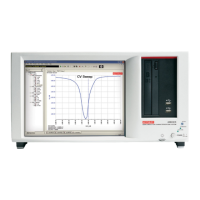4200-900-01 Rev. K / February 2017 Return to Section Topics 3-151
Model 4200-SCS User’s Manual Section 3: Common Device Characterization Tests
Explanation of flash UTM parameters
NumPulseTerminals(int) The number of pulse terminals, or pulse channels, to use
for the test. The number of pulse terminals ranges
from one to eight.
PulseTerminals(char *) A string representation of all the VPU channels being
used in the test, matching the number given in
NumPulse. For example if the setup is such that VPU1
Channel 1 and VPU2 Channel 2 are being used, then
PulseTerminals should look like this:
VPU1CH1,VPU2CH2. There are no spaces in this list
of channels.
Pulse1Voltages(double) Array of voltage values for the pulse height (0 V
referenced) of first pulse on each pulse channel. Valid
values range from -20 V to +20 V. All voltage levels
assume a 50 Ω load. In order to float a channel
(disconnect pulse output from a DUT pin), using the
Solid State Relay, use -999. Minimum time required
for a SSR open or close is 100 µs.
PrePulse1Delays(double) Array of time values used as a delay before the first
pulse is output. Valid values range from 20 ns to 1 s in
10 ns increments (s).
TransitionTimesPulse1(double) The amount of time it will take the first pulse to
rise/fall (0-100%/100-0%) from the BaseValue (0 V) to
the given Pulse Voltage. If the pulse voltage level is
from -5 to +5 V, then the valid transition times are from
20 ns to 33 ms in 10 ns increments, else if pulse
voltage is within -20 to +20 V, then valid values range
from 100 ns to 33 ms in 10 ns increments (s).
Pulse1Widths(double) Array of values defining the pulse widths for the first pulse
of each channel. Minimum values are 20 ns to 1 s.
Pulse width is defined as FWHM, so it includes half of
the fall time and half of the rise time (transition time), in
seconds.
PostPulse1Delays(double) Array of time values used as a delay after the first
pulse is output (that is, time at the 0 V base voltage).
Valid values are 20 ns to 1 s in 10 ns increments (s).
Pulse2Voltages(double) Array of voltage values for the pulse height (0 V
referenced) of second pulse on each pulse channel.
Valid values range from -20 V to +20 V. All tests
assume a 50 Ω load. In order to float a channel, or
disconnect from a DUT pin, using the Solid State
Relay, use -999. Minimum time required for a SSR
open or close is 100 us.

